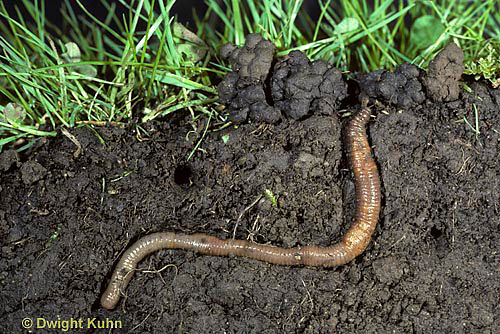Soil Structure
How is the species Lumbricus terrsteris useful
in its
environment? This question was briefly answered in the section
Habitat, but will be
explored more in depth in this section. Earthworms have also been
useful to their ecosystes, and are even used by many farmers
throughout histor, to provide optimum growing conditions for their
crops. Earthworms play a huge role in the makeup of the soil around
them. How do they affect this? Yasemin Kavdir, in the Book the
Biology Of Earth Worms, 2011 explains , Earthworms are very
importent contributers to the enviornment, by creating casts,
burrows and digesting soil (Kavidir 2011). By digging around in the soil,
consuming, and digesting the soil, and then excreting the soil, as
well as making homes in the earth. This in turn can decide the
makeup of the plant life in which the earth worm lives
(Kavidir 2011)

Earthworms can ingest soil and produce waste matter, known as a
cast, which in turn creates aggregates in the soil. They can break
down large aggregates into smaller one. After ingesting soil and
plant matter the soil is compacted in the crop, or gut of the
earthworm, and the egested or in simpler terms excreted. An
aggregate is defined by Kavidir, 2011, as the following; “aggregates are
formed through the combination of clay, silt, and sand with organic
and inorganic substances” (Kavidir 2011).. By producing aggregates,
the soil texture, properties, and ability to hold moisture takes a
turn for the better. So by creating these the L.
terrsteris, can “improve physical structure of the soil,
increase drainage and aeration, enhance soil fertility, recycle
nutrients, reduce run-off, supply better conditions for plant root
growth”. Aggregates can also create strength and soil tension in the
ground, and help to tabalize the soil make-up. Aggregates provide a
premium hot spot for a plants roots to grow, because of its nutrient
content, its ability for CO2 to reach the roots, and the
ability for the surrounding area to contain just the right amount of
water for the plant to uptake. Aggregates however are not the only
reason the soil is made better by earth worms for the plants
(Kavidir 2011).
Earthworms move horizontally through the soil while feeding and
creating burrows. By doing this, they make the soil useful for plant growth. While
the particular species L. terrsteris does not make as many
burrows as other species of earthworms, they continue to use the
same burrows, their burrows are useful making the soil the way it
is. Burrows allow the soil deeper down to contain macropores, which
allow air and water to reach these areas. This earthworm also brings
decomposing matter to its burrows which also can increase the
nutrient properties, like polysaccharides, enzymes, and
other plant nutrients of the soil (Kavidir 2011).
these areas. This earthworm also brings
decomposing matter to its burrows which also can increase the
nutrient properties, like polysaccharides, enzymes, and
other plant nutrients of the soil (Kavidir 2011).
In conclusion Earthworms are very beneficial to their environments,
especially the soil.
They produce aggregates, casts and burrows, and provide hot spots
for plant root growth. They break apart the soil and make large
aggregates into to smaller compact ones, and create pores in the
soil. All along with the pores created by aggregates, burrows can
allow for soil aeration, or an easier passage of gasses though the
soil. The earthworm activity can increase drainage and water flow in
the soil, to provide the perfect of moisture for the roots of plants
to take up. This species also increases the amount of sugars,
enzymes and other plant nutrients, by ringing decaying matter to its
burrow and by creating casts. Earthworms are useful to the farmer,
the plant life, and in turn can provide for their entire ecosystems
(Kavidir 2011)
To learn more about the Lumbricus terrsteris move on to Interactions page!
Check out where we gathered our information from on our Reference page